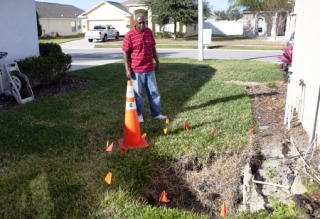|
Article Courtesy of The St. Petersburg Times By Shelley Rossetter Published December 28, 2011 PLANT CITY — When Carla Chapman moved to Trapnell Ridge, she thought she'd found her dream home. Located on Berry Blossom Lane in a subdivision nestled among strawberry fields, the new, two-story house seemed idyllic. For a while, it was. At least until the earth opened beneath Chapman's feet. Twice. The first sinkhole occurred in 2010, the second about a year later. Both times, she happened to be standing in her back yard. Both times, she fell in.
the soil sampling and ground testing required by law and was approved for construction. That doesn't mean it's immune to Mother Nature. In 2010, more than a dozen sinkholes opened in eastern Hillsborough County after a record 11-day cold snap forced strawberry farmers to pump massive quantities of water to protect their crops. That same year, Willie Reese, who lives next door to Chapman, noticed cracks reforming in his drywall. He had repaired them once a couple of years ago, thinking they were a sign of normal house settling. This time, he had them checked. An engineer provided by his insurance agency confirmed his fears: sinkhole activity beneath the home. A foundation stabilization process, known as underpinning, was performed. Even so, he still doesn't feel safe. "We have January and February coming up; who's to say what's going to happen when the weather changes, when the frost comes?" Reese said. He also worries about neighboring properties, like Chapman's, with problems not yet repaired that could affect the safety of his home. And worst of all, he worries his retirement home has turned into a life sentence. "I feel like I've been taken advantage of," he said. "Something I paid thousands and thousands of dollars for, I can't get any money for." Saira Chaudhry knows the feeling. Her family moved into a house across the street from Reese in 2010 and only learned of the sinkhole activity afterward. "When we moved in, all the neighbors said, 'Why did you buy here?' " she said. Like Reese, Chaudhry's home has cracks. The tile on her kitchen floor resembles a spiderweb, despite being replaced since she moved in. Her insurance agency has assured her it is a sign of the house settling, she said. Chaudhry is not convinced. "We spent all our savings money to buy this house; now we feel trapped," she said. "We are just hoping for the best." The good news: The insurance company may be right, said Terry Doolittle, a plans examiner and building inspector for Plant City. "When you build on sand, there will be some settlement with anything," Doolittle said. "Stress cracks don't necessarily indicate a sinkhole. (It) could be just normal settlement of the earth." Doolittle hasn't seen an increased amount of sinkhole activity in Trapnell Ridge, particularly, he said. But there has been an uptick in sinkholes since the 2010 freezes. This year, about 18 homeowners in the city have submitted plans for stabilization permits, he said. That doesn't necessarily mean the homes had sinkholes because the process is also done for settling. Yet even stabilization can't protect a home if a large sinkhole opens beneath it. "Unfortunately, it does happen sometimes," Doolittle said. And it's not always something that can be predicted. When a new development is planned, site work must be done to determine where utilities, retention ponds and more will be placed, Doolittle said. Tests are conducted to determine soil types, and soft spots are hunted. But every inch can't be covered. "Every now and then, something gets missed and then we have situations like these," Doolittle said. Some residents have consulted a law firm to see if they have a case. But no one seems to be sure who, if anyone, is at fault. For Chapman, the thought of someone else going through what she did, scares her the most. "What if an elderly person or a child had fallen into those holes?" she said. "It's frightening." As for her home, it no longer feels like the dream she bought into in 2006. "Part of owning a home is to have a back yard for family activities, to play with a dog, to have a room without a ceiling," she said. Now, she has no choice but to steer clear of her own yard, and step gingerly. |
